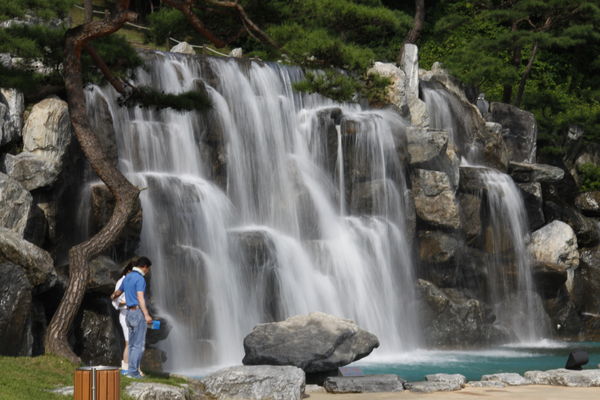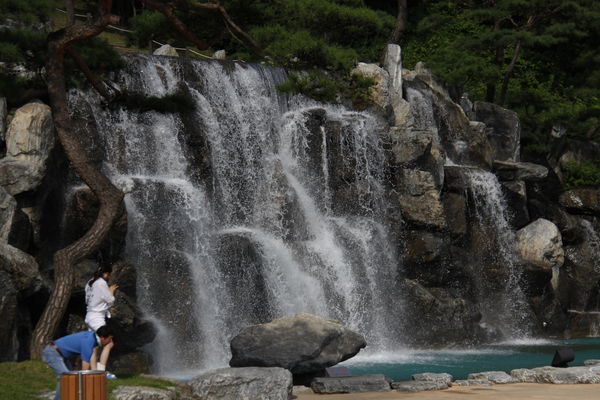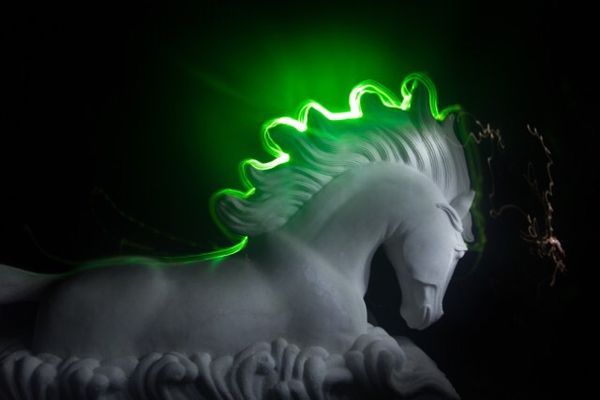Using Manuel Settings
Nov 13, 2014 09:03:23 #
pithydoug wrote:
Now wait. My old xti is in a closet someplace but my newer canon shows 10 meaning 1/10. They DO NOT show the "/". So when she says 10 she means 1/10.
In a later post she did say 10 sec. - Dave
Nov 13, 2014 09:13:45 #
Shellback wrote:
Check these out for manual shooting...
All Manual Mode Shooting
Manual Mode Cheat Sheet
Basics of manual settings
Everyone should have this committed to memory Sunny 16 rule
Have fun ;)
All Manual Mode Shooting
Manual Mode Cheat Sheet
Basics of manual settings
Everyone should have this committed to memory Sunny 16 rule
Have fun ;)
The Manual Mode Cheatsheet link is incorrect......do you have the correct one?
Thanks.
Nov 13, 2014 09:25:44 #
MaryAnn wrote:
I thought 10 seconds would be how long to do it....but I am now thinking after watching a couple of things on you tube that maybe 2 seconds would give me the look I wanted.
I shoot water quite often although in the mountains, streams and waterfalls. I shoot mostly ISO 100 but at various focal lengths and f stops. To get that soft water look I usually shoot from 1/10 to 1/30 of a second although doing the opposite is cool too, stopping the water in mid drop shooting at 1/640 second. Here are a couple of examples. You should be able to see the file information in your file manager/explorer. If your 10 is 10 seconds it is for sure over exposed and looks like no photo in the camera.


Nov 13, 2014 11:55:32 #
MaryAnn wrote:
I have a Canon T3i and a Canon SX 50 HS. I shoot ... (show quote)
Have you heard of the SUNNY 16 RULE.
Can't tell you what you are doing wrong, but can make a suggestion to help you with a series of changes and dependencies that can change your results. Proper exposure can be obtained with full manual settings on your camera.
Sunny 16 has been around since early film days. It was the result of the unavailability of light meters for most photographers in early photography. Sunny 16 involves a correlation between the nature of lighting, the aperture, the shutter speed and film speed (ISO).
The first thing to do to begin to use and understand SUNNY 16 is to take your camera OFF automatic IS0. True manual operation involves YOU controlling all three aspects of the triad for exposure, which include Shutter Speed, Aperture, AND film (or sensor) speed.
SUNNY 16 works just as well on learning appropriate ratios of the three elements of exposure. What most people overlook is that digital cameras are picking one of those elements all over the map unless ISO is taken off Automatic, and set near the native ISO for the sensor which is usually from 80 to 200 ISO. Low light can be factored in, but you must control it.
This offering by B&H explains turning off your meter, going strictly manual, and using the light under which you are shooting help you choose shutter speed and aperture relative to the light conditions and ISO setting.
With film, if your film speed was 200, and in sunny conditions, and the aperture set to f16, then shutter speed would be the reciprocal of the film speed, which in this example 1/200th.
In the example you posted everybody has made the assumption your shutter speed was Waaaaaaaaaaaay too slow, resulting in over exposure. This looks to be true.
With film, ISO was based on the film. With digital the ISO setting is the third controllable function of the exposure triad. However, if you are using ISO on Automatic, you are not controlling the camera fully manual.
I never shoot my camera's with automated ISO, unless I am using the camera on fully Automatic on all choices of the triad. When I am shooting full manual, I set my ISO to 200 and keep it there, unless the light conditions dictate otherwise.
The way we used to deal with low light with film was to buy faster film, typically limited on the high end to 1600. Film speed above that was typically considered surveillance film.
Once you understand SUNNY 16 and how to vary it, it's easy to check it out on digital because of the possibility of setting your ISO for each image. With film, all the settings were in the camera, but you needed a different roll of film to test various ISO's.
I am NOT suggesting that you uses SUNNY 16 exclusively and from now on. I am merely suggesting that understanding how SUNNY 16 works will take any photographer a large leap forward toward fully understanding the nature of lighing conditions in changing exposure settings, including the third most important setting... manual control of ISO.
Switch off every automatic function of the exposure triad for FULL manual operation. Shutter Speed, Aperture and ISO. Learn then how switching each one on to automatic affects the results as in controlling fast action, static landscape, Depth of Field.
So here is the B&H article on disregarding your meter and setting ALL your exposure factors manually, including ISO.
The link to B&H SUNNY 16:
http://www.bhphotovideo.com/explora/photography/tips-solutions/sunny-16-rule
So, if you trully
Nov 13, 2014 12:13:35 #
MaryAnn wrote:
I thought 10 seconds would be how long to do it....but I am now thinking after watching a couple of things on you tube that maybe 2 seconds would give me the look I wanted.
MaryAnn,
Under the conditions you describe, even 2 seconds of the shutter being open will still be far to fast, and over exposure will still result because the aperture would have to be too small an opening (and probably not attainable on your lens) to still give you a viewable image.
On sunny days, with a reasonable ISO and Aperture, the shutter speed would be more like 1/400th or 1/250th of a section, at something like an ISO of 400 and aperture of f8-f16.
Nov 13, 2014 12:16:57 #
Kuzano wrote:
MaryAnn,
Under the conditions you describe, even 2 seconds of the shutter being open will still be far to fast, and over exposure will still result because the aperture would have to be too small an opening (and probably not attainable on your lens) to still give you a viewable image.
On sunny days, with a reasonable ISO and Aperture, the shutter speed would be more like 1/400th or 1/250th of a section, at something like an ISO of 400 and aperture of f8-f16.
Under the conditions you describe, even 2 seconds of the shutter being open will still be far to fast, and over exposure will still result because the aperture would have to be too small an opening (and probably not attainable on your lens) to still give you a viewable image.
On sunny days, with a reasonable ISO and Aperture, the shutter speed would be more like 1/400th or 1/250th of a section, at something like an ISO of 400 and aperture of f8-f16.
I think you mean "far too long" or "far too slow" not fast.
Nov 13, 2014 12:29:04 #
amfoto1
Loc: San Jose, Calif. USA
dsmeltz wrote:
She said was using a speed of 10 not 1/10. The t3i has a shutter speed range of 1/4,000 to 30. A setting of 10 is more that a little softening.
That shutter speed range is 1/4000 of a second to 30 full seconds. So, "10" can show up on the LCD readout twice, indicating two very different shutter durations.
On T3i or any other Canon, a readout of 10 would indicate 1/10 of a second. On the other hand, a readout of 10" indicate ten full seconds.
In this case, it really doesn't matter. Shooting outside in sunlight, it's way, way too bright to get an exposure at either 1/10 or 10 seconds. Even setting the camera to the lowest possible ISO (100) and the lens to the smallest possible aperture (f22 probably), in broad sunlight the slowest usable shutter speed will be 1/50 or 1/60. On an overcast day, it might be possible to get as slow as 1/25 or 1/30.
Hence, the need for a neutral density filter, if wanting to get into slower shutter speeds in broad daylight. However, I would recommend a four-stop or six-stop ND filter, to get into the range of shutter speeds that the OP appears to be trying to use.
At 1/10 shutter speed ocean wave action will be slightly blurred. At 10 full seconds, the same wave action will be extremely blurred, probably will look more like fog than water. When "dragging the shutter" like this, to do deliberate motion blurs, first you need to be using a tripod (an image stabilized lens may make it possible to handhold 1/10... but not 10 seconds). Also, it pays to bracket your shots or experiment with different shutter speeds to try to get the look you are wanting. In time, experience might guide you... but initially it can be hard to predict how the image will look.
Nov 13, 2014 12:47:13 #
MaryAnn wrote:
I have a Canon T3i and a Canon SX 50 HS. I shoot ... (show quote)
On the SX50, maybe on the other camera as well, try it first using the "Program" mode and use the +/- exposure adjustments, etc and watch the results. Then on each camera, set them to Tv (Shutter Priority) and set your shutter speed and watch where the camera sets the other parts of the Exp Triangle. THEN when you fully understand what is happening you can move on to Manual settings.
The T3i probably figured the settings would not give a usable file so didn't snap. With the SX50 it most likely just gave you what you requested, essentially a fully blown-out overexposure.
On a SUNNY day, you will probably need a STRONG neutral density filter to set the cameras the way you had them.
Nov 13, 2014 14:14:04 #
JPL wrote:
It appears she was after the 'blurry water" look which requires a slower shutter. Problem was she overexposed the shots because of not understanding that you can't simply set a slow shutter in manual and shoot. It requires an understanding of the exposure triangle, as others have pointed out. You want a slow shutter speed, it requires a smaller aperture and/or a low ISO setting. If that doesn't get it, then an ND filter or a polarizer.I can only guess what look you are after. But on a sunny day on the beach I think you should try to set your camera like this, 1/5th shutter speed, ISO 100 or lower if possible, F22 or higher number if possible. Try this and go from there. You should at least get some kind of picture with those settings.
Not being the slightest bit familiar with Canons, what I'm hearing is that she paid no attention to the meter, as she is used to shootin in full auto, rather picked an arbitrary shutter speed and started shooting.
Try these 4 links that tie Shutter/Aperture/ISO together
http://www.craftsy.com/blog/2013/09/understanding-shutter-speed/
http://www.craftsy.com/blog/2013/09/understanding-aperture/
http://www.craftsy.com/blog/2013/09/understanding-iso/
http://www.craftsy.com/blog/2013/09/creating-proper-exposure/
Nov 14, 2014 02:07:57 #
dsmeltz wrote:
I think you mean "far too long" or "far too slow" not fast.
Caught me!.... ooops!
Nov 14, 2014 03:14:41 #
Shellback wrote:
Check these out for manual shooting...
All Manual Mode Shooting
Manual Mode Cheat Sheet
Basics of manual settings
Everyone should have this committed to memory Sunny 16 rule
Have fun ;)
All Manual Mode Shooting
Manual Mode Cheat Sheet
Basics of manual settings
Everyone should have this committed to memory Sunny 16 rule
Have fun ;)
Yes, the "Sunny 16" rule:
A great starting point. At f/16 use shutter speed of 1/ISO number as the shutter speed in seconds. So for full sun, that gives f/16 at 1/100 s for ISO 100. A more useful equivalent exposure could be f/8 at 1/400 s for ISO 100.
Actually she would need to experiment a bit more because it is usually brighter at the beach on the sand and the Sunny 16 rule is a bit off there.
Skill with manual exposures come with experience. There have been times where I shot film with no meter or automation what so ever. With time you get to know the light.
If she wanted blurred water she might need a high value neutral density filter to get long enough exposures.
She should also experiment with both Av & Tv exposures before attempting Manual exposures.
Nov 14, 2014 03:18:09 #
waegwan wrote:
I shoot water quite often although in the mountain... (show quote)
The first photo was the look I was going for. Thank you for posting it.
Nov 14, 2014 15:23:49 #
pithydoug wrote:
Sure a ND will do it or maybe even a polarizer or other tricks of the trade. I sill think she needs to understand the basics so she understands the why. The next day she might want to shoot a flower stamen or stop a train that passes by her house. Once you understand the triangle, manual or any of the bias settings are a cake walk.
:thumbup: :thumbup: :thumbup: :thumbup: :thumbup:
Nov 19, 2014 13:10:56 #
MaryAnn, I first began my photography journey almost two years ago. I started out using Manual and I have been working in Manual ever since. There will be lots of people that tell you to work in Aperture Priority or Shutter Priority or even to just stay in Auto. While you might be very successful doing that for many things, you will never truly understand exposure the way you could if you discipline yourself to work in Manual. Because you do not understand exposure, you ended up with blown photographs. There is a really good book that will start you on your manual journey.
http://www.amazon.com/Understanding-Exposure-3rd-Photographs-Camera/dp/0817439390/ref=sr_1_1?ie=UTF8&qid=1416420016&sr=8-1&keywords=bryan+peterson+understanding
Will you have a complete understanding if you read this book? No. The only way to come to a complete understanding is to work in manual and shoot something everyday. In manual, you will be able to make your own choices in your exposure. It is hard at first, but in my opinion it is worth it.
In order to take a long exposure shot in bright daylight you may need to use a Neutral Density Filter. But you have to understand exposure before you use one. Here is an excellent article on ND(Neutral Density) filters.
http://www.redbubble.com/people/peterh111/journal/4421304-the-ultimate-easy-guide-to-neutral-density-filters
Here is a link to a shot I took with a very dark ND filter on my camera. It is so dark that you cannot even see through it. You have to focus before putting it on the lens. I took this shot in the late afternoon. It was a 22 second exposure.
http://500px.com/photo/81209045/high-falls-from-the-west-bank-of-beaver-river-by-sandra-nightski?from=user_library
Many people will tell you not to use manual until you are an experienced photographer. I will tell you that the inexperienced phototgrapher is the one that needs to work in manual more than anybody. It was hard, I had lots of opposition, but I am so happy I stuck to my guns on this issue. I learned so much more than I would have if I had listened to the naysayers.
If you ever want to pm me with a question please do .. If I can't help you, I will direct you to someone that can.
.... and Mary Ann .. I believe you have live view on that T3i .. use it to learn. Look at your meter and look at your live view and learn.
~Sandra
http://www.amazon.com/Understanding-Exposure-3rd-Photographs-Camera/dp/0817439390/ref=sr_1_1?ie=UTF8&qid=1416420016&sr=8-1&keywords=bryan+peterson+understanding
Will you have a complete understanding if you read this book? No. The only way to come to a complete understanding is to work in manual and shoot something everyday. In manual, you will be able to make your own choices in your exposure. It is hard at first, but in my opinion it is worth it.
In order to take a long exposure shot in bright daylight you may need to use a Neutral Density Filter. But you have to understand exposure before you use one. Here is an excellent article on ND(Neutral Density) filters.
http://www.redbubble.com/people/peterh111/journal/4421304-the-ultimate-easy-guide-to-neutral-density-filters
Here is a link to a shot I took with a very dark ND filter on my camera. It is so dark that you cannot even see through it. You have to focus before putting it on the lens. I took this shot in the late afternoon. It was a 22 second exposure.
http://500px.com/photo/81209045/high-falls-from-the-west-bank-of-beaver-river-by-sandra-nightski?from=user_library
Many people will tell you not to use manual until you are an experienced photographer. I will tell you that the inexperienced phototgrapher is the one that needs to work in manual more than anybody. It was hard, I had lots of opposition, but I am so happy I stuck to my guns on this issue. I learned so much more than I would have if I had listened to the naysayers.
If you ever want to pm me with a question please do .. If I can't help you, I will direct you to someone that can.
.... and Mary Ann .. I believe you have live view on that T3i .. use it to learn. Look at your meter and look at your live view and learn.
~Sandra
Nov 19, 2014 14:29:58 #
Nightski wrote:
MaryAnn, I first began my photography journey almo... (show quote)
Thank you so much for the information. I have been trying to discipline myself to shoot something in manual everyday. At least my photos are not all white like before. I haven't kept them but that is ok. The only thing that I have shot in manual that I have kept was a light painting night that my photography club had. Hopefully it is onto attach it here.

If you want to reply, then register here. Registration is free and your account is created instantly, so you can post right away.









